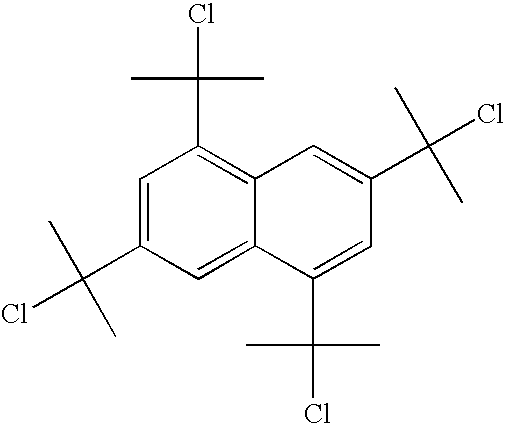Method for producing chlorinated hydrocarbon having chlorinated tertiary carbon
a technology of chlorinated hydrocarbon and tertiary carbon, which is applied in the field of chlorinated hydrocarbon having chlorinated tertiary carbon production, can solve the problems of reducing yield, reducing yield, and introducing chlorine into only a desired position with high selectivity, and achieving commercially stable yield and stable selectivity. , the effect of stable product quality
- Summary
- Abstract
- Description
- Claims
- Application Information
AI Technical Summary
Benefits of technology
Problems solved by technology
Method used
Image
Examples
example 1
[0054] To a conical beaker were fed 0.14 kg of toluene and 0.03 kg of 1,4-bis(2-hydroxy-2-propyl)benzene (p-DIOL, manufactured by MITSUI PETROCHEMICAL Co., LTD.) and then added 0.25 kg of 35 wt % aqueous hydrochloric acid. This resulting mixture was stirred with a magnetic stirrer for 90 minutes at 20° C. At this time, both of organic and aqueous layers changed to transparent and colorless. After the organic layer was separated from the aqueous layer, a hydrogen chloride gas was bubbled through the organic layer for 90 minutes at 20° C. under stirring with the magnetic stirrer. Then, in order to remove hydrogen chloride, a nitrogen gas was bubbled for 45 minutes. A sample solution of the resulting toluene solution of 1,4-bis(2-chloro-2-propyl)benzene (p-DCC) was devolatilized by distillation. The subsequent measurement of a 1H-NMR spectrum of the resulting p-DCC (crude) showed a purity of 99.5%. The resulting solution of p-DCC had high quality comparable to p-DCC produced by crystal...
example 2
[0055] The target compound was produced as in EXAMPLE 1 except that 35 wt % aqueous hydrochloric acid was used in an amount of 0.125 kg and the contact reaction with the hydrogen chloride gas was performed at 5° C. As a result, p-DCC with 99.5% purity determined by NMR was produced. The resulting solution of p-DCC had high quality comparable to p-DCC produced by crystallization from an organic layer and drying, and was able to be satisfactorily used as an initiator for cationic polymerization.
example 3
[0056] To a glass separable flask, having a capacity of 0.002 m3, equipped with a thermometer, a baffle, and a stirrer were added 1,4-diisopropylbenzene (0.045 kg), monochlorobenzene (0.03 kg), and an aqueous solution of sodium hypochlorite (1.2 kg, 0.9 mol / kg) under stirring and cooling in an ice bath. Subsequently, concentrated aqueous hydrochloric acid (0.08 kg, 35 percent by weight) was slowly added dropwise to the solution through a dropping funnel over a period of 3 minutes and stirring was continued for 60 minutes. After the reaction, the organic layer and the aqueous layer was separated by standing. To the separated organic layer was added concentrated hydrochloric acid (0.03 kg, 35 percent by weight), and then the resulting mixture was vigorously stirred for about 5 minutes to deactivate the hypochlorous acid finely dispersed in the organic layer. The resulting organic layer was separated to obtain a monochlorobenzene solution of the reaction product. The yield of 1,4-bis(2...
PUM
| Property | Measurement | Unit |
|---|---|---|
| temperature | aaaaa | aaaaa |
| temperature | aaaaa | aaaaa |
| temperature | aaaaa | aaaaa |
Abstract
Description
Claims
Application Information
 Login to View More
Login to View More - R&D
- Intellectual Property
- Life Sciences
- Materials
- Tech Scout
- Unparalleled Data Quality
- Higher Quality Content
- 60% Fewer Hallucinations
Browse by: Latest US Patents, China's latest patents, Technical Efficacy Thesaurus, Application Domain, Technology Topic, Popular Technical Reports.
© 2025 PatSnap. All rights reserved.Legal|Privacy policy|Modern Slavery Act Transparency Statement|Sitemap|About US| Contact US: help@patsnap.com



